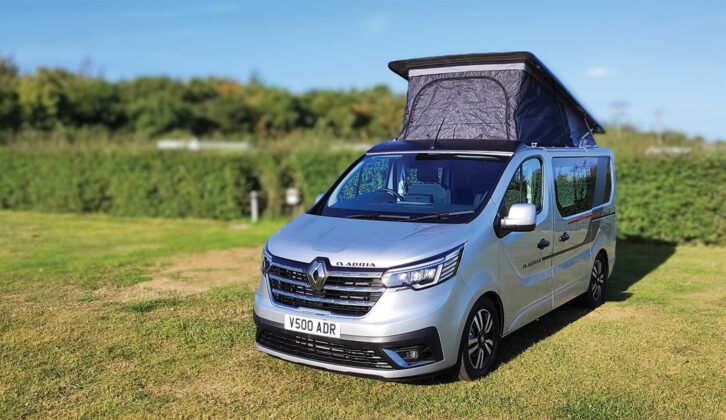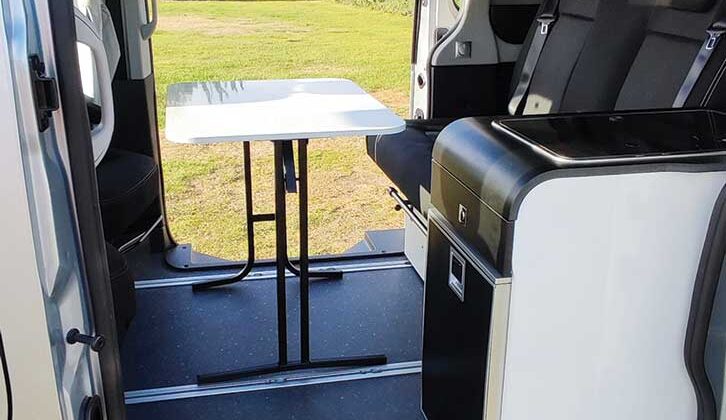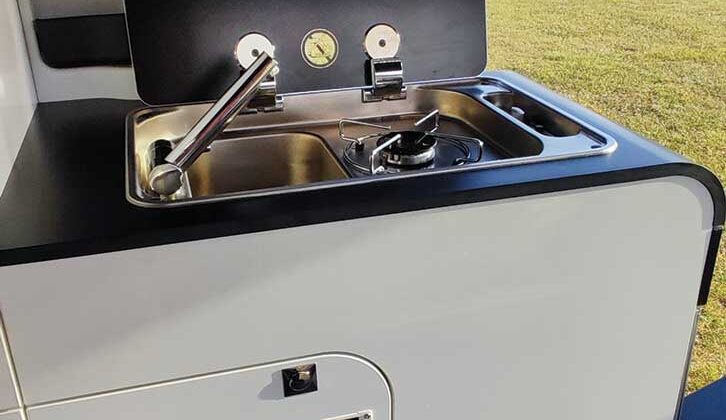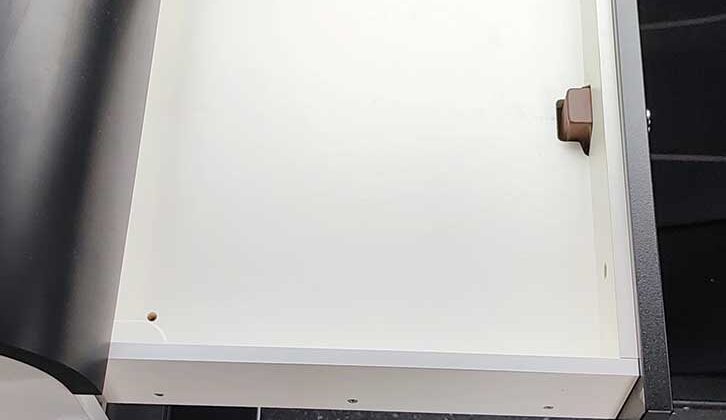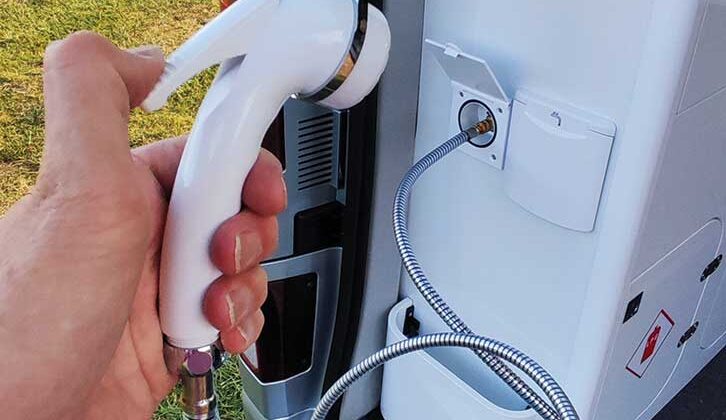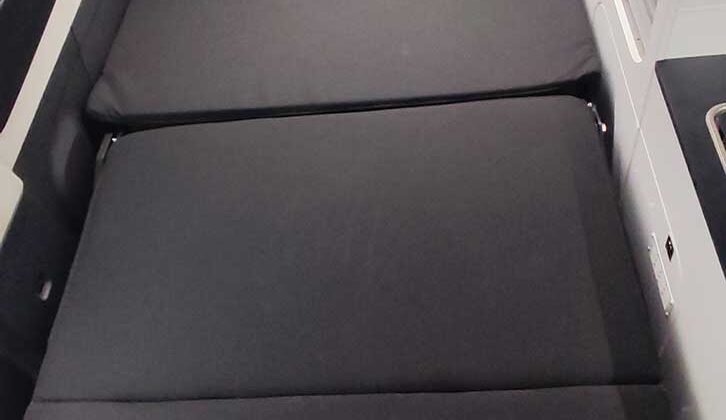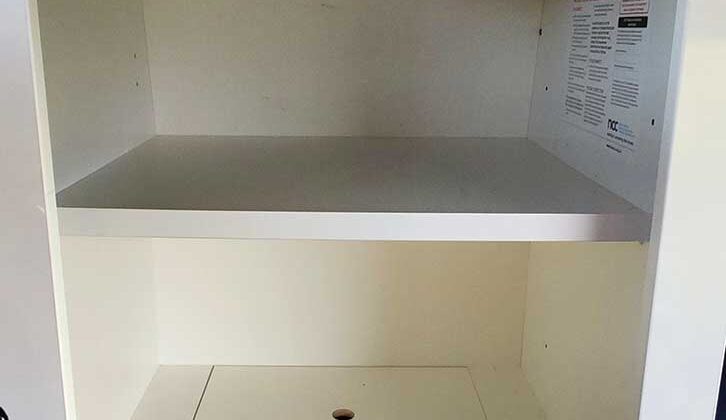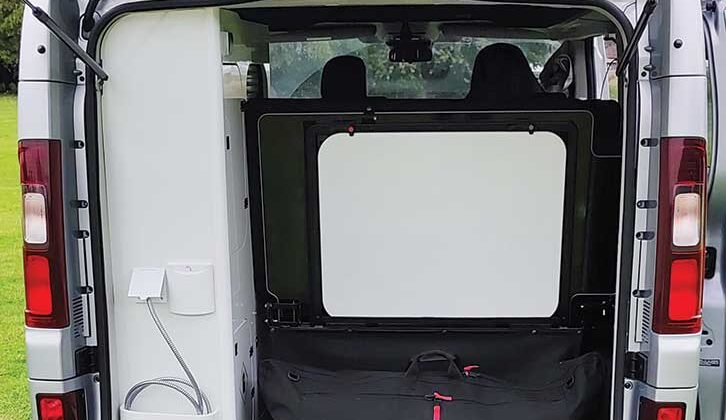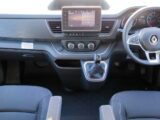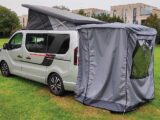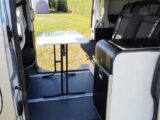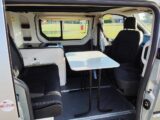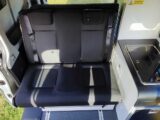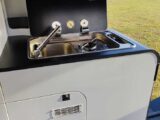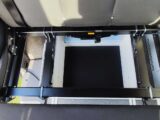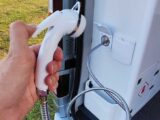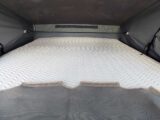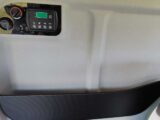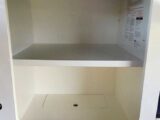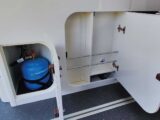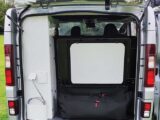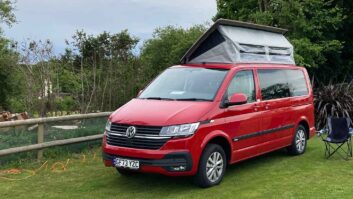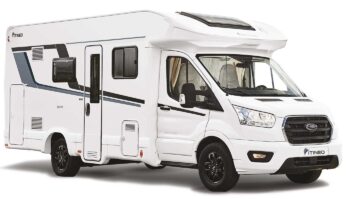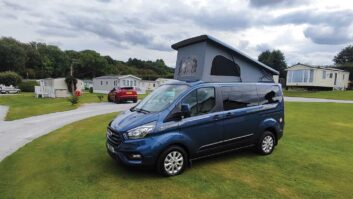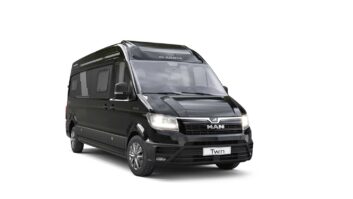Verdict
It’s had several false starts, but the Adria Active Duo that has finally appeared on these shores is a well-made product with a sensibly sized and stored table and a very superior rising-roof (if you can handle the absence of separate windows). I would perhaps have liked to see more kitchen storage – but there is only so much you can expect in this space. The optional awning makes it even more versatile, too.
Pros
- Well-made rising-roof
- Comfortable seating
- Useful tailgate awning option
Cons
- Storage is a little on the thin side
The Adria Active Duo is a Renault-based camper that has been available on the Continent for a couple of years now, but as is often the way, its transfer over to the right-hand drive environment of the UK has taken a little more time.
This is partly due to the base vehicle: Renault wanted the version of the Trafic with two sliding doors to be used for this purpose – hence the ‘Duo’ in the name – which meant a bit of juggling around with the design.
The vehicle made a brief debut at the February NEC motorhome show last year, only to be withdrawn for alterations. When it reappeared, it impressed the judges in our recent Motorhome of the Year awards so much that it won the best small campervan category.
Just before it achieved that accolade, I took the Active Duo for a spin for almost a week – first around the coast of Essex, then up to West Yorkshire and back again. This is what I thought of the model that features in our best campervan guide.
It initially launched with an OTR price of £62,795, but recently, Adria announced it was having its price lowered to £52,990.
Exterior and cab
As standard, the Adria Active Duo comes with a Glacier White non-metallic finish. Our test model, however, was kitted out in Comete grey-metallic finish (£1040), and also had the optional 17-inch alloys (£805), so looked very sporty.
The Renault Trafic isn’t that common a base vehicle, but it’s actually quite difficult to understand why it isn’t seen far more often from campervan converters, especially in its newest formation.
I found it made for a very smooth and steady drive – perhaps not quite as zippy as the Transit Custom, even with the 150bhp engine that you get with the optional automatic gearbox (£4975), but not that far off.
Out on the road, given its slightly chunkier look than that vehicle, I was impressed with its turning circle. I took the Duo into Wivenhoe in Essex, all the way down to the harbour, and not once did I find myself having to make a three-point turn.
Admittedly, our test model came with the optional parking sensors, which made squeezing down those narrow lanes a little less stressful.
The rear bench seat includes two belted travel seats, both with Isofix fixings. And having two doors actually makes this ’van even more suitable as a day-to-day vehicle, because both rear passengers can get out easily, with the one on the nearside only having to squeeze slightly to get past the kitchen peninsula.
The cab includes a substantial media screen, with drinks holders and a large tray behind it. Although I had the optional automatic gearbox, that still left a conventional handbrake between the seats. If you are likely to want to swivel the driver’s seat, this could take some negotiation.
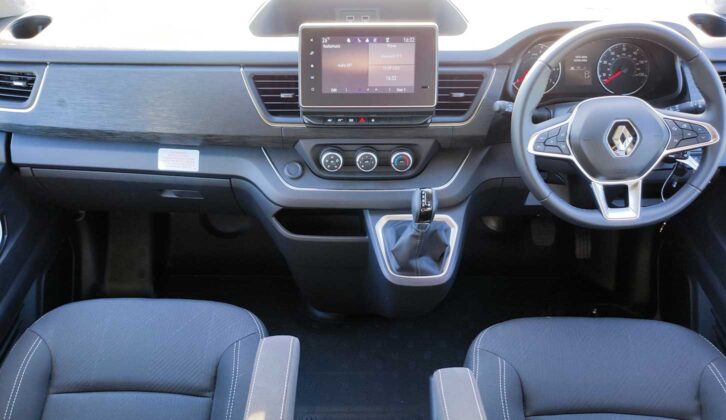
Once on site (see: the best campervan campsites if you’re wondering where to tour next), you’ll find the mains hook-up connection just behind the driver’s door – anyone climbing into or out of the rear offside door will therefore need to be aware that it’s there, to avoid tripping over it. The water connection and gas bottle, however, are located at the back, where you will also find an external shower.
The pop-up roof has clearly been thought through ergonomically. You just unclip the seatbelt-style fastening on the roof over the cab (there’s even a patch of Velcro to help you keep the clip out of the way), take hold of the grab handles, then slip aside the catch next to both handles and push the roof up.
No nuts to undo or rucksack-style straps to fiddle with. Elastic towards the back of the roof also ensures that the canvas folds neatly when you pull the roof back down.
The side awning is part of the optional Comfort Pack (£3590). As a further option, the Active Duo comes with a dedicated tailgate awning (£580), which fastens onto the tailgate itself, only requires minimal pegging, and could have a variety of uses, including on-site bike storage.
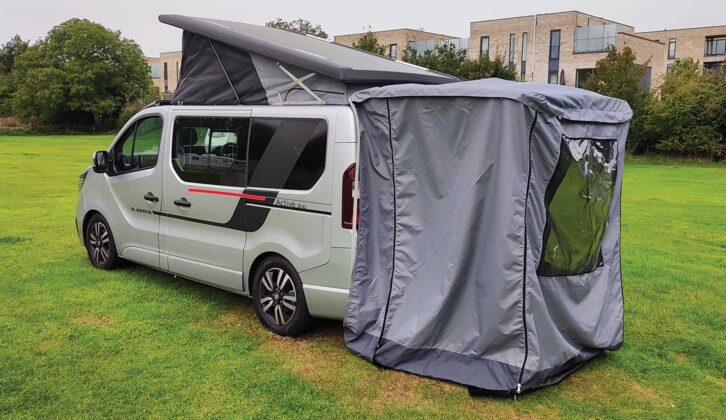
Even so, initially putting it up could well be a two-person job. I’m 6ft 6in and I had to ask somebody to help haul the thing up in the first place, and that was in quiet weather. A windy day might be a challenge! It does at least pack down into a small, light bag that you can stow behind the bench seat.
Lounge in the Active Duo
Having two opening doors really does make a difference to the ventilation inside the Active Duo.
Once you master the handbrake, the cab seats swivel easily – and they are also the most comfortable seats in the ’van for relaxing.
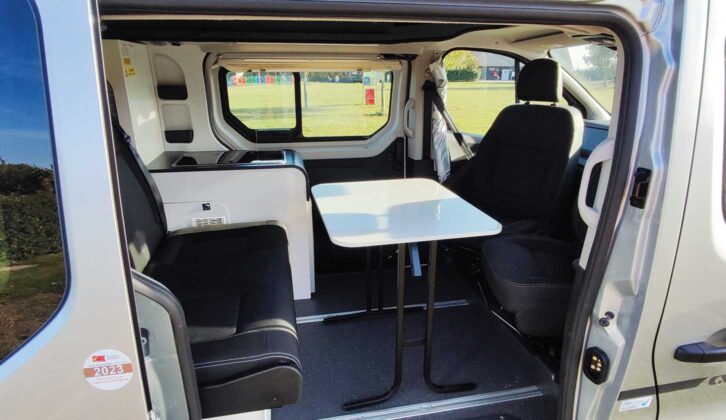
There is a slight step between the cab and the main lounge, but it is barely noticeable. A heating vent from the Webasto diesel heater by the nearside door (an optional extra) should keep things cosy in winter (check out our campervan heater guide to see our top picks, too).
You can, of course, slide the bench far enough forward to make a footrest if you are not using the table. The table itself is stored in a dedicated holder behind the bench (this is one change that was made from the initial launch vehicle in February) and is also light enough to be folded out easily, with plenty of room for four to dine.
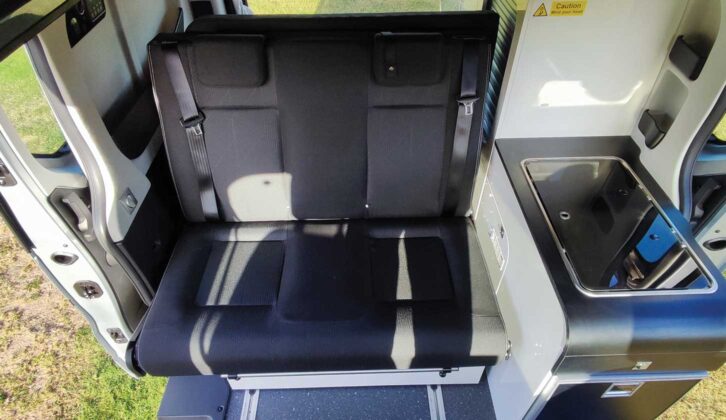
A switch on the offside wall controls the offside striplight and the ceiling light for night-time illumination. The control panel is also on the offside, next to a USB and USB-C port.
You might want to roll out the side awning to eat outside. If the day is a bit blustery and you want a little more shelter, at a pinch you could use the tailgate awning as well – there is enough room for somebody to perch on the rear edge of the ’van, so you would only really need a couple of extra chairs. But this would be quite a remove from the kitchen.
When I first saw them, I wasn’t sure about the rather papery concertina blinds on the side windows, because they looked a bit fragile. But they do the job well and have plastic clips to hold them in place when they are up.
Even more impressive are the cab blinds – an unusual standard feature in a camper. They fit together easily and are a refreshing change from the metallic pads you usually struggle with.
Kitchen in the Adria Active Duo
The peninsula kitchen includes a one-burner hob with a sink alongside.
The 42-litre fridge is located at the end of the peninsula, where it would be easily accessible to anyone outside as well – even if the awning is on the other side. There’s a small drawer above it that could serve as a cutlery drawer.
It is pleasingly very easy to work here while sitting on the bench seat, once you have it correctly positioned. The striplight offers all the illumination you need, and there is just enough permanent workspace available to make use of the 12V and mains socket located up near the roof.
There are two cubbyholes here for essential ingredients – just as well, because most of the storage in this side unit can only be accessed from behind the bench seat.
Washroom
There is no washroom in the Adria Active Duo as standard – it’s a typical ‘VW style’ layout that doesn’t have room for a separate washroom.
The storage area under the bench seat is, however, big enough to house a standard-size Porta Potti – although because storage is at something of a premium in this vehicle, you might think twice about taking one.
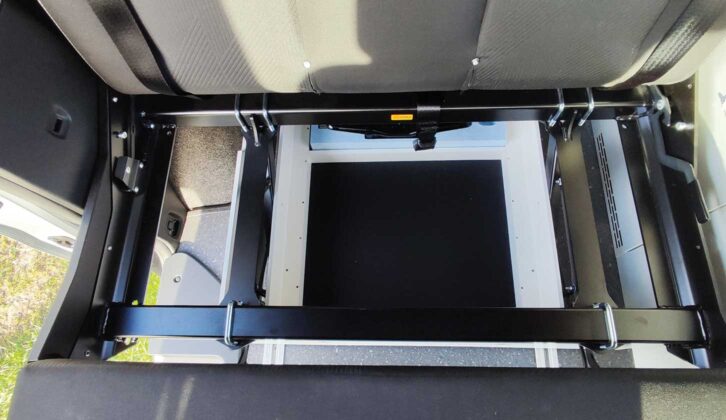
If you opt for the tailgate awning, though, you could always use it as a temporary washroom. There’s plenty of room for a portable toilet for a campervan, and the external shower is already here.
The awning should provide a good degree of privacy, too, as there’s only one small mesh window. You might need something on the floor, as the awning has no built-in groundsheet.
Sleeping in the Adria Active Duo
The rock’n’roll bed can be easily folded down and moved into the best position. You’ll find that when you do this, the switch for the extra light at the back of the vehicle is easily accessible, so this can become your reading light. The extra mains socket here is perfectly located for charging devices.
The roof bed is also just a quick hop up, and very comfortable. You get two uplighters for reading, and there is easy access to the switch for the light in the cabin underneath, should you need to descend during the night.
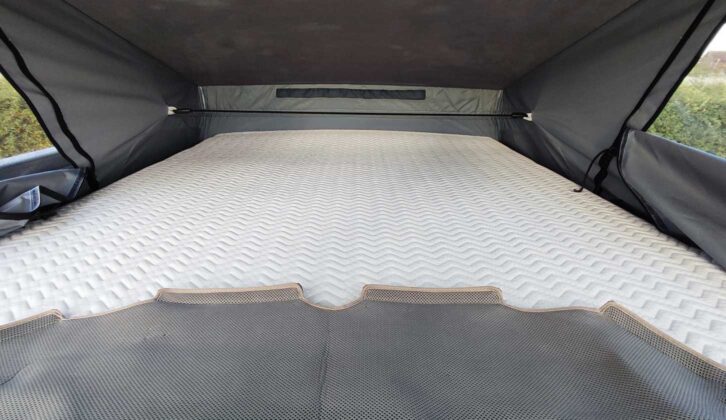
Usefully, you can completely seal off this upper area with a material flap that can be stretched to fit the access hole and fastened with Velcro.
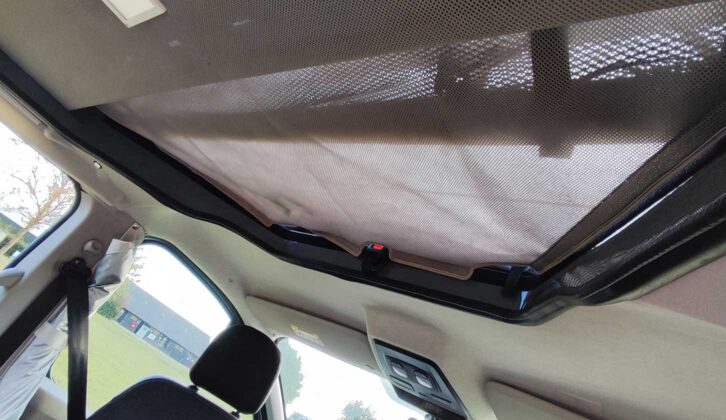
Smaller children can also be hemmed in with a safety net, although I did find that the hooks for fastening this on the edge of the roof got in the way of the bed base when I was trying to press it into position.
At this point, it’s also worth saying something about the windows up here. Most rising-roofs have three windows – one at the front and one on each side, usually semicircular in shape.
But as with the Twin Sports models, the motorhome manufacturer has decided to dispense with that formation here, and instead has mesh around all three sides, with a solid opaque canvas inside, which you can remove in its entirety.
Removing this is quite a fiddly operation, particularly as you have to navigate around the roof struts.
It might be ideal if you are using the roof to watch a sporting event above the crowds, say. But if you just want to admire the view when you wake up, you will probably be restricted to making a small opening with the zip.
There is, at least, a small vent in the back of this rising-roof, which is something that you don’t see very often in similar vehicles.
Storage in the Adria Active Duo
Storage is at a premium here – but then, it is in most vehicles featuring this campervan layout, as the rising-roof means there are no overhead lockers.
There is a sizeable storage area under the bench seat, which you access by lifting the base cushion. You might need to decide whether to house a Porta Potti in here.
There is also a small shelf on the offside to the side of the bench seat, underneath the control panel.
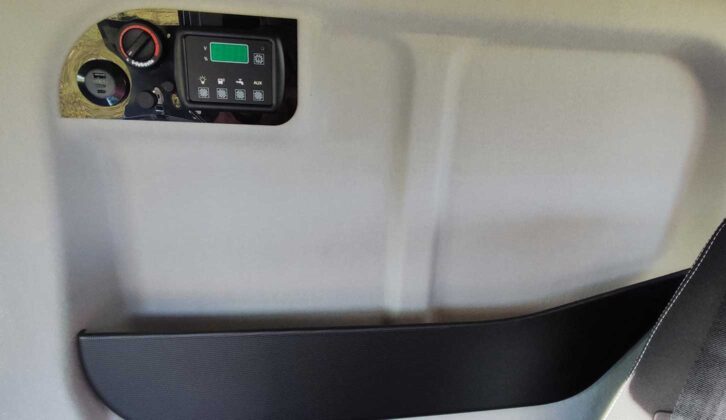
All the rest of the storage is located in the side unit on the nearside, and most of it is easily accessed with the bench seat slid right forward.
In addition, there is a tambour-door cupboard with two shelves, which are deep enough for either large food containers or smaller clothes.
Below this and set slightly further forward, another shelved cupboard holds the battery, but would safely have a small amount of room for odds and ends. Then further back still is another shallower cupboard, which is split in two and fitted with retainers.
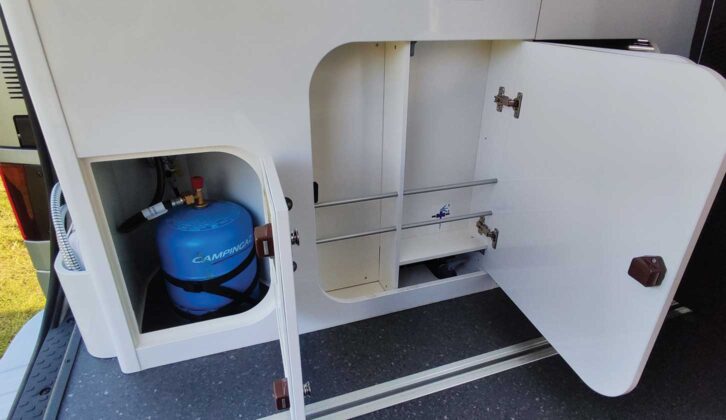
You might also have room to store a few items in the small gas bottle locker at the end and in the cubbyhole below the shower attachment.
That said, this kind of layout, with a seat that can slide right forward, is often touted as the perfect choice if you are likely to have to use your ’van for transporting bulky goods as well as going on tour.
As it happened, I had the opportunity to try this out for real with the Adria Active Duo, and it more than passed muster by carrying all of the luggage of one young student who was returning to her college for the start of the new term.
Equipment in the Active Duo
The base vehicle is probably the most unusual ingredient in this whole set-up. The rest of the Active Duo’s spec is much more conventional.
A 110bhp engine is perhaps a shade less powerful than you’d find elsewhere, but I didn’t notice any performance dip.
You have cruise control as standard, and the Comfort Pack will get you cab carpets. Other driving options include a rear-view camera, automatic wipers, fog-lights and parking sensors.
The 42-litre fridge is quite large for a camper, the 14-litre water tanks fairly standard.
That same Comfort Pack will also get you the Webasto diesel heater. Other campervan manufacturers might include this in the standard price.
The external shower is a bonus, while the optional tailgate awning is a welcome – and very useful – inclusion.
I also particularly like the clever way the rising-roof fastens and unfastens in this vehicle. It feels a good deal more secure than others I have seen and I didn’t have any trouble with the canvas spilling out.
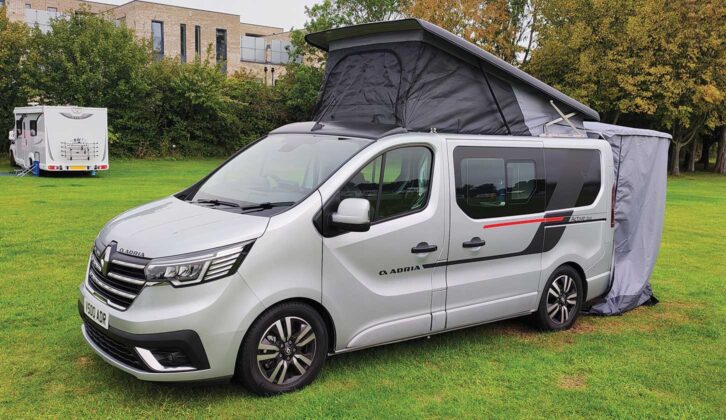
Buy if…
You’re looking for a well-built campervan that you can also use easily as a day-to-day vehicle (for up to four people), and you’re happy with choosing a campervan that has a base vehicle other than a Volkswagen.
Alternatives to the Active Duo
The Wellhouse Misano 4.1 comes on a Ford Transit base vehicle and has an excellent level of spec. The sensibly designed Leisuredrive Renoir is made by a company with years of experience and comes with several interior finishes. Then there’s the Campaway Casa, a sociable ‘van which has a lot fitted in, including a toilet.
Technical spec of the Adria Active Duo
- Price: From £52,990 (£67,515 as tested)
- Sleeps: 4
- Belts: 4
- Base vehicle: Renault Trafic
- Engine (as tested): 2.0-litre, 150bhp with optional automatic gearbox
- Length/width/height: 4.99/1.96/1.99m (16’4”/6’4”/6’5”)
- MTPLM: 3010kg (est)
- Payload: 623kg
- Water (fresh/waste): 14/14 litres
- Leisure battery: 100Ah
- Gas: 1 x 2.7kg Campingaz
Base vehicle
- Chassis: Renault Trafic Engine 2.0-litre Blue dCi
- Power: 150bhp (optional extra) Torque 258lb @ 1500rpm
- Transmission: Automatic (optional extra)
- Features include: Cruise control, LED daytime running lights, ABS EBD as standard, rear-view camera, parking sensors, fog-lamps and automatic wipers as options
Conversion
- Comete grey metallic exterior (optional extra – standard Glacier White), 17-inch alloy wheels, third brake light, tailgate awning (optional extra)
Lounging and dining
- Alaska White furniture, Java/Leather Vaast upholstery, LED ceiling and spotlights, mains, 12V, USB and USB-C
Kitchen
- One-burner hob with inline sink, 12V socket, 42-litre fridge
Sleeping
- Roof bed: 2.0 x 1.21m
- Lower bed: 1.9 x 1.10m
Equipment includes
- Webasto Air Top 2000 SCT heater, aux battery (part of £3590 Comfort Pack), DC/DC converter, external shower, cab blinds
If you’ve enjoyed reading this article, why not get the latest news, reviews and features delivered direct to your door or inbox every month. Take advantage of our brilliant Practical Motorhome magazine SUBSCRIBERS’ OFFER and SIGN UP TO OUR NEWSLETTER for regular weekly updates on all things motorhome related.
Technical Specifications
| Berth | 4 |
| MiRO | 2387 kg |
| Payload | 623 kg |
| MTPLM | 3010 kg |
| Shipping Length | 4.99 m |
| Width | 1.96 m |
| Engine Size | 2000 cc |
